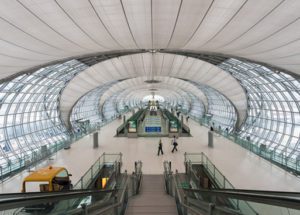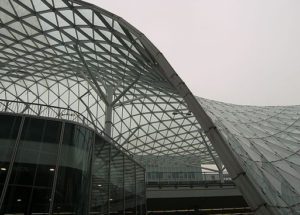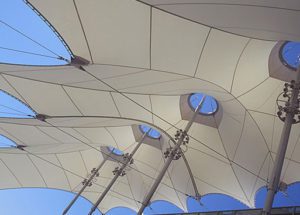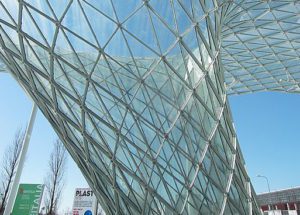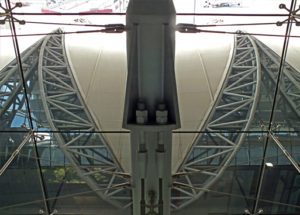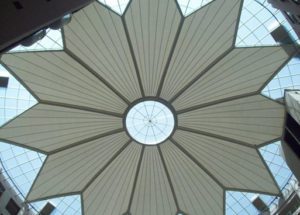A predominantly concrete, steel and glass structure, Bangkok’s Suvarnabhoomi Airport has large fabric spans that impart a very distinct look. Interestingly, the overall shape of the structural unit is a very simple one
If you have noticed the beautiful fabric canopies on shopping mall terraces and office buildings you surely would have wondered how this relatively new material is quickly gaining popularity. And, if you have visited the Bangkok Suvarnabhoomi Airport you must have been left spellbound by the large fabric structures that impart such a distinct look to the aesthetic of the airport building.
Fabric structures are a sub category of tensile structures and use specialized fabrics under tension to support self-weight and take care of the live load providing a very cost effective and dramatic building material that can span large distances without intermediate supports. Fabrics can be translucent and lend themselves to create good acoustics. They also help reduce internal infrared radiation and noise to a great extent. Fabric structure take very less onsite time to erect since most of the manufacturing takes place offsite and they roughly cost half the conventional concrete and steel structures. Being lightweight and flexible, fabric reacts better to natural loads than a rigid material.
How does a tensile fabric structure work? To understand this quickly, take out your handkerchief and hold four corners between two people. Pull it fairly hard on all four corners. This structure cannot take any load in the centre without sagging. Now bring two diagonally opposite corners to ground as if you are pegging them to your table keeping the other two corners at the same height and with the same tension or pull. This forms a very stable ‘saddle’ structure that can take live loads like wind or snow and support self- weight without any sagging whatsoever. All areas of the fabric are now under tension. If you were to draw two lines on this surface across the two corners, they will have opposite curvature: one positive and the other negative.

This kind of surface demonstrates the fundamental rule for stability; a fabric structure under tension must curve equally in opposite directions. This gives the structure its three dimensional stability.
In reality, large fabric structures are sup- ported using steel support structures and tensioning cables. Architects and engineering experts collaborate to create stunning forms that are highly functional.
There is a large variety of fabrics that various companies recommend, but as far as external use is concerned, there are three main types: PVC coated polyester; Silicone coated glass and Teflon coated glass. Typically the life of the fabric is assumed to be twenty years by design.
At the Suvarnabhoomi Airport in Bangkok, the 108 membrane bays were designed as a three-layered system to meet very stiff technical requirements. Daylight, acoustics and energy balance were paramount. The three-layer membrane roof structure consists of an outer skin of Teflon coated glass fabric, a highly transparent sound-insulating middle layer of thermoplastic elements, and a sound absorbing inner layer with a defined light transmission.
The internal infrared levels are dramatically reduced and a very high noise reduction has been achieved.
Of course, apart from witnessing the great functionality of the design, when you pass through one of these bays you will stop and marvel at the scale and beauty of the massive fabric spans that scale large distances with a simple but striking natural shape.

